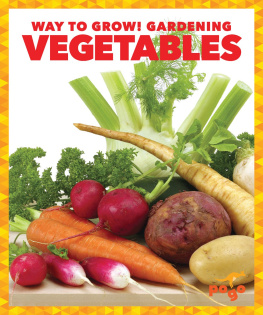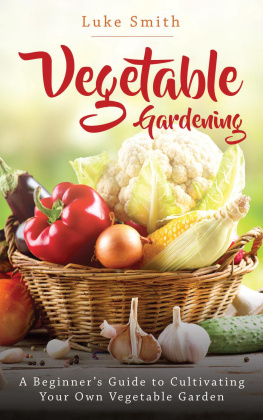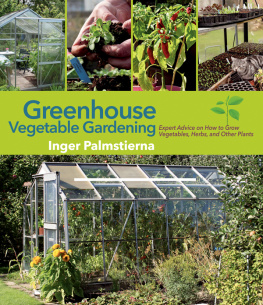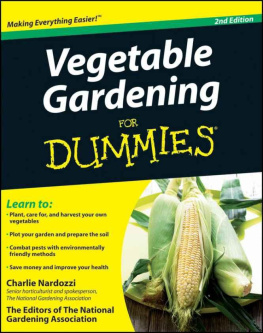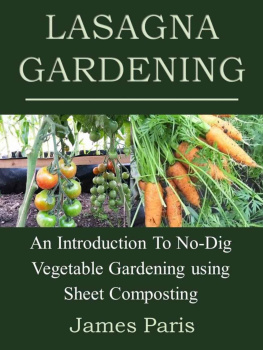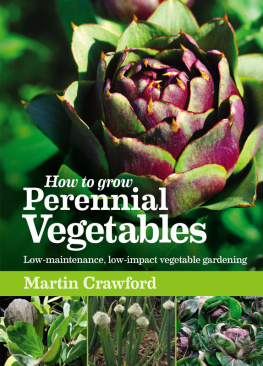Nancy Blitzer - Vegetable Gardening Secrets: Learn How to Grow Your Own Vegetables
Here you can read online Nancy Blitzer - Vegetable Gardening Secrets: Learn How to Grow Your Own Vegetables full text of the book (entire story) in english for free. Download pdf and epub, get meaning, cover and reviews about this ebook. year: 2011, publisher: Nancy Blitzer, genre: Romance novel. Description of the work, (preface) as well as reviews are available. Best literature library LitArk.com created for fans of good reading and offers a wide selection of genres:
Romance novel
Science fiction
Adventure
Detective
Science
History
Home and family
Prose
Art
Politics
Computer
Non-fiction
Religion
Business
Children
Humor
Choose a favorite category and find really read worthwhile books. Enjoy immersion in the world of imagination, feel the emotions of the characters or learn something new for yourself, make an fascinating discovery.

- Book:Vegetable Gardening Secrets: Learn How to Grow Your Own Vegetables
- Author:
- Publisher:Nancy Blitzer
- Genre:
- Year:2011
- Rating:5 / 5
- Favourites:Add to favourites
- Your mark:
- 100
- 1
- 2
- 3
- 4
- 5
Vegetable Gardening Secrets: Learn How to Grow Your Own Vegetables: summary, description and annotation
We offer to read an annotation, description, summary or preface (depends on what the author of the book "Vegetable Gardening Secrets: Learn How to Grow Your Own Vegetables" wrote himself). If you haven't found the necessary information about the book — write in the comments, we will try to find it.
Nancy Blitzer: author's other books
Who wrote Vegetable Gardening Secrets: Learn How to Grow Your Own Vegetables? Find out the surname, the name of the author of the book and a list of all author's works by series.
Vegetable Gardening Secrets: Learn How to Grow Your Own Vegetables — read online for free the complete book (whole text) full work
Below is the text of the book, divided by pages. System saving the place of the last page read, allows you to conveniently read the book "Vegetable Gardening Secrets: Learn How to Grow Your Own Vegetables" online for free, without having to search again every time where you left off. Put a bookmark, and you can go to the page where you finished reading at any time.
Font size:
Interval:
Bookmark:
Vegetable Gardening Secrets
Learn How to Grow Your Own Vegetables
How Growing Vegetables Can Save You Money
If you are like most people, you are looking for a way to cut corners and save some money. There are a few things that you can do to save money today. You can travel less and use less gasoline. You can cut down on utility expenses by not using so much electricity and heat. You can eliminate eating out and eat at home. Perhaps you are already doing this but need to save more money. One way that you can save a lot of money is with your food bill. And with food prices going up, this may end up being a necessity. Not only can you save money on your food bill, but you can also start eating healthier.
You have probably heard about organic foods. These are foods that are all natural and do not contain any chemicals or preservatives. Organic vegetables are in your local supermarket and usually cost a lot more than the other vegetables that are grown using chemical pesticides and other toxins. You have probably heard that organic vegetables are better for you, but do not want to spend the extra money. After all, the idea is to save money - right? So spending extra money on organic vegetables, that are usually smaller than other vegetables can seem like a bad financial deal. And if you are like most of us, you are looking to get more bang out of your buck. Especially at the supermarket.
The way to really save money and eat healthy at the same time is to grow your own vegetables. This can trim your food bill substantially, depending on the amount of vegetables that you grow. If you have a patch of ground, you can save money by growing your own vegetables in the soil and wind up with vegetables and fruits that are healthier than those that you buy in the store. You can save at least $100 a month by growing your own vegetables and this savings, if you take the tips in this book, can be used after the harvest time if you learn how to preserve the various vegetables and fruits.
Think of what you can do with $100 a month. It can pay a couple of bills for you or just ease the burden for you a bit. And this savings can continue to blossom. You will see savings in your food bills every month when you start to grow your own vegetables. Of course, you will have to wait until harvest time to start to really start saving the money, but after your first harvest, you can save money all year long using the tips in this book. There are also tips that I will give you that will enable you to start saving money relatively soon with herbs.
It takes work to plant and harvest a vegetable garden, but it is good work. Working in a garden and planting vegetables or fruits is actually therapeutic. Many people enjoy being outdoors and gardening just for the heck of it. When you are saving money because of your endeavors, it makes the experience even better. The hard work is getting your garden started and harvesting as well as preserving the foods. Breaking this down, this consists of about 4 days out of the year. The rest is just maintenance. Four days is not much to ask when it comes to saving $100 a month on your grocery bills.
And best of all, you can start right now. Spring is the perfect planting time for a vegetable garden. By harvest time, which will be in July or August, you will be well on your way to start saving money.
If you are ready to start saving $100 a month in your food bill by growing your own vegetables, take the tips in this book and put them to use. Eat healthy foods and stop wasting your money at the grocery store.
Vegetables Gardens - An Old Idea
Most of us today do not remember victory gardens. These were gardens that people planted during WWII to supplement rations during the war. During WWII, just about everything was rationed, including food. So people began to supplement that rationing with food from their own garden. Because the country was at war, the gardens that people used to supplement their war rations were dubbed Victory Gardens.
The country is currently at war with a recession. A war that requires a victory. Isnt it about time for Victory Gardens again? Just as our grandparents and great grandparents created victory gardens during WWII, we can do the same today. We arent on food rations, although some of us might as well be. With an increasing number of people losing their jobs and facing home foreclosures, some of us may be rationing ourselves.
We dont have to feel helpless in the face of recession. We can do something about it. We can declare victory against the recession by planting our own victory gardens. All you need is a plot of soil and plants. The cost to prepare a garden is minimal, especially when you consider that it can save you $100 a month or more by growing your own vegetables.
Growing Vegetables From Seeds Or Plants
If you are planning on starting a vegetable garden to save money the first thing that you need to consider is whether you are going to start from seeds or plants. Seeds are much less expensive, but take longer to grow. You need to grow plants from seeds in an indoor environment if you live in a four season climate. If you are planning on planting your garden soon for a late summer harvest, then you need to use plants. You can buy vegetable plants at any gardening center. They are much sturdier to put into the ground and have a better chance of taking root and producing vegetables. There are pros and cons to using both seeds and plants when it comes to growing your own vegetables.
Seeds - Pros and Cons
Seed come in packets and you can purchase them at most gardening and big box stores. The best aspects about using seeds is that you can grow them yourself into plants in your own home and make sure that the soil you use as well as any plant food used is organic. The seeds are also much less expensive than plants. There is also the satisfaction that you will gain when you are growing your own seeds for your plants.
The negative aspects about seeds is that you need more time to grow them so that they can take root. If you live in a four season climate, you need to grow the seeds indoors so that they can grow into sturdy plants before you can put them in the ground.
If you live in a climate that is warm, you can put down seeds and get them to grow into plants after sowing them in the ground. Seeds are also used for larger garden areas as it would be impractical to use plants.
Plants - Pros and Cons
You can find plants that can be used for your vegetable garden in any garden store. They are ready to plant and will produce fruit or vegetables. Plants are easy to use and if this is your first garden, they can be easier to space. Plant are already sturdy enough to be transferred to the ground and will bear fruit or vegetables.
The negative aspect of using plants is the cost. They tend to cost more than seeds. They are also often grown in soil that is filled with pesticides. If you decide to use plants instead of seeds, look for those that have been grown organically.
If you are a first time gardener, you may prefer to use plants over seeds. What many gardeners do, and what I did, is to use plants in your first garden so that you can get the garden seasoned and become familiar with planting and harvesting. Then the next year, you can cultivate your own plants from seeds.
Remember that if you live in a four season climate, you will want to use plants for your first garden as they have already taken root and are easier to grow. As you become more adept at gardening, you an start to easily grow vegetables from seeds.
What To Grow
After you have figured out the concept of planting with seeds or plants, you can then decide what you want to grow. Naturally, for your first project you will want to make it easy on yourself. Some of the easiest fruits and vegetables that you can grow include the following:
Next pageFont size:
Interval:
Bookmark:
Similar books «Vegetable Gardening Secrets: Learn How to Grow Your Own Vegetables»
Look at similar books to Vegetable Gardening Secrets: Learn How to Grow Your Own Vegetables. We have selected literature similar in name and meaning in the hope of providing readers with more options to find new, interesting, not yet read works.
Discussion, reviews of the book Vegetable Gardening Secrets: Learn How to Grow Your Own Vegetables and just readers' own opinions. Leave your comments, write what you think about the work, its meaning or the main characters. Specify what exactly you liked and what you didn't like, and why you think so.


